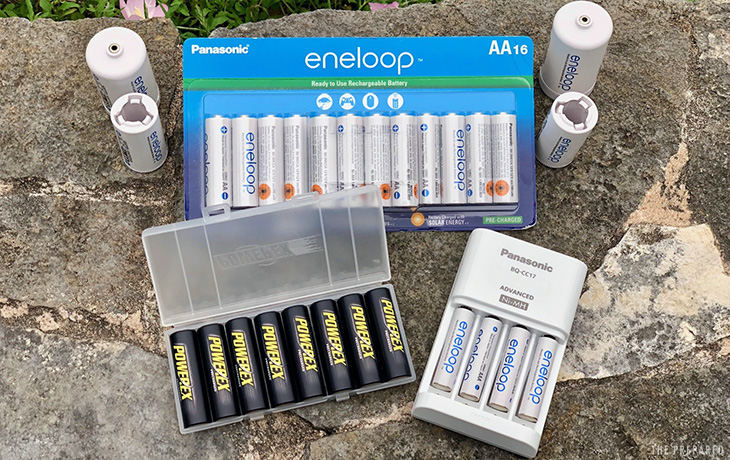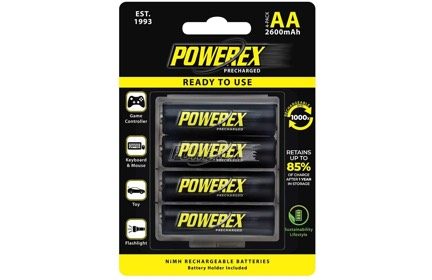This is an easy win for any prepper: remove the common alkaline batteries found around your house in remotes, lights, clocks, and other gear, set them aside in a cool place for storage, and move to rechargeables. Pick up one or more high-quality battery chargers, and you’re set.
Not all rechargeables work the same way. Experts recommend the NiMH LSD battery chemistry over the better-known lithium-ion style whenever possible. But NiMH only comes in the AA family, so if you’ve got 18650s, CR123As, or other uncommon sizes, be sure to buy Li-Ion with cell protection and a micro-USB charging port built in.
Reviews: Portable battery packs (non-removable battery versions) and disposable batteries.
More: Not sure about battery types and when you’d use which one and why for emergency preparedness? Check out the beginner’s guide to batteries for preppers.
AA-family rechargeable batteries
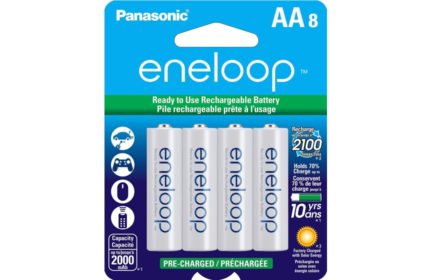
Best for most people:
Panasonic Eneloop
The best rechargeable batteries for preppers are Panasonic Eneloop AA NiMH LSD 2100-cycle batteries (AA) and AAA 8-packs. These Eneloops hold at least 70% of their charge for 10 years when sitting on a shelf, making them perfect for prepping.
The low self-discharge (LSD) variants of the market-leading Eneloop NiMH batteries combine an insanely high number of charge/discharge cycles without sacrificing too much capacity. The 2100-cycle Eneloops are the lowest capacity (2000mAh) but longest lifespan batteries in the Eneloop family — there’s often a tradeoff between how much energy a NiMH battery can hold at once vs. how many times that battery can be recharged. Preppers should usually go with the higher charge cycle variants, which also happen to be cheaper than their higher-capacity siblings.
That’s part of the reason why there aren’t many contenders to pick from. Even when you set aside the counterfeits and low-quality products, there just aren’t many choices that offer the higher lifespan variant. Quality competitors, like PowerEX, only offer choices at the higher capacity / lower cycle count tier.
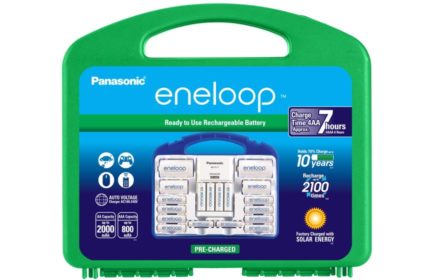
Great starter pack:
Panasonic Eneloop Super Power Pack
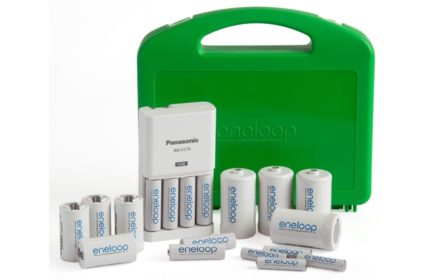
If you have many C/D:
Panasonic Eneloop Plus Pack
If you’re just getting started with Eneloops and have a wide range of battery-powered gear, we recommend the Eneloop Super Power Pack as the best bang for your buck. It comes with 12 AA batteries, 4 AAA batteries, two AA-to-C adapters, two AA-to-D adapters, a smart battery charger, and a plastic case. You can replace decades worth of disposable alkaline batteries with just this one kit. If you have a lot of gear that takes C and D batteries, you should go with the Plus Power Pack — it has half the number of AA batteries (six), and twice the number of C and D adapters as the Super Power Pack, and is a few dollars cheaper.
When you’re moving all your daily-use batteries over from alkalines to Eneloops, you’ll want to keep a supply of pre-charged replacement batteries on-hand in the appropriate sizes. That way, when a rechargeable gets low, you can immediately replace it with one of the charged batteries you have on standby. You’ll then recharge the low battery and have it on standby for when the next battery runs down.
Given the need for pre-charged standby batteries, you’ll probably need to supplement the packs above with more AA and AAA. As you build up this spare battery stash, be sure to stick with the regular 2100-cycle Eneloops, and avoid the more expensive batteries with a lower cycle count.
Eneloop alternative:
PowerEX AA Rechargeable Batteries
Equally as good as the Eneloops, but with different specs, are PowerEX NiMH LSD batteries. The PowerEX advertise fewer recharge cycles than the Eneloops, but they have two distinct advantages: price and brand safety. Specifically, the PowerEX batteries are cheaper than their Eneloop equivalents, and because they’re so rare they’re far less likely to be counterfeited. So if you can find PowerEX NiMH LSDs in stock, snap them up.
For devices that take larger C or D cells, you have two rechargeable options:
- If it’s a critical prep or a daily use item, consider shelling out for high-quality NiMH LSD C or D cells. The best rechargeable C and D cells are the PowerEX C 2-pack, or the PowerEX D 2-pack
- For non-essential and/or very infrequently used devices, you can pair a higher-capacity, lower-cycle AA rechargeable with a C or D adapter. That way, you can raid that device for AAs in a pinch. The best higher-capacity NiMH LSDs for preppers are the 500-cycle, 2700mAh PowerEX Pro AAs, which at roughly $25 for an 8-pack are just two-thirds the price of the more popular 500-cycle, 2500mAh Eneloop Pro AAs.
We normally try to offer a budget choice, but in this case it’s better to save up for the main choices. Unfortunately, in this market, the popular budget options — Amazon Basics and IKEA LADDA — are slightly higher capacity but have less than half the lifespan of the Eneloop 2100s. It’s also the case that Amazon sources many of their batteries from different factories in China, so quality is all over the map.
Ultimately, preppers should invest in fewer batteries that will last a lot longer, rather than going for quantity over quality. If you have to bug out, you’ll wish you had a small stash of Eneloops rather than a large pile of budget rechargeables or alkalines.
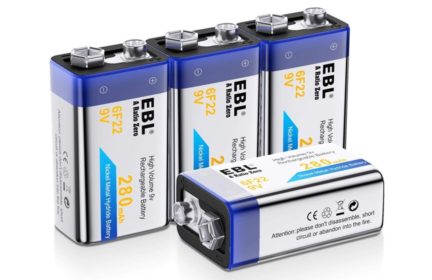
Best for most:
EBL 9V
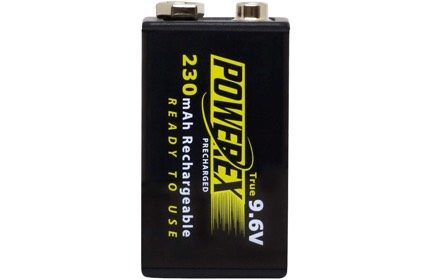
Upgrade:
PowerEX 9V
The Eneloops do not come in 9V, so for that size we like the EBL 9V battery 4-pack. The EBLs are relatively inexpensive and get great reviews. Or, if you want an upgrade in quality vs. the EBLs, you can pick up the PowerEX 9V NiMH LSD 9V. But the PowerEX are significantly more expensive for less capacity, so only go there if you want Eneloop quality in a 9V package.
Non-AA sizes and rechargeable lithium-ion batteries
Unfortunately, the better NiMH LSD chemistry isn’t available in form factors outside of the AA family (AAA, C, D, 9V). So if you have a flashlight, firearm optic, or other gear that takes an unusual battery, you have two choices:
- Use lithium-ion rechargeable tech instead
- Don’t use rechargeables in that gear
We recommend picking up some of the best disposable batteries for gear that you rarely use (eg. a flashlight in your emergency bag that turns on once a year) and/or for gear that uses button- or coin-style batteries (eg. CR2032s used in popular rifle optics).
Quality disposables are better for rarely-used gear because they hold their charge while sitting on a shelf for much longer than a rechargeable. For the unusual and flat battery sizes, it’s just not worth recharging those small, infrequently used batteries, so don’t bother.
For daily-use gear or products which take cylindrical batteries that kinda look like they’re in the AA family (but aren’t), you’ll want to buy protected Lithium-Ion batteries with a built-in USB charging port.
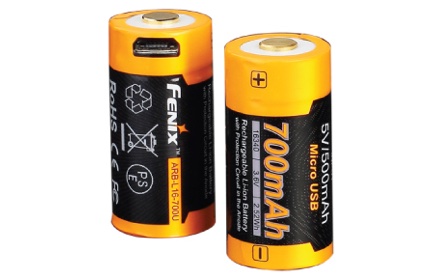
Rechargeable CR123A:
Fenix 16340
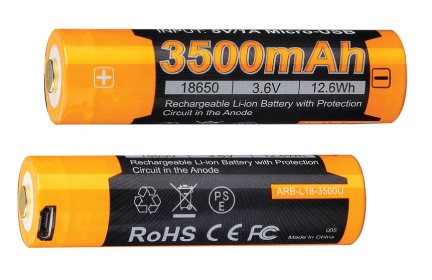
Trusted value:
Fenix 18650
The best rechargeable CR123A battery for preppers is the $9 Fenix 16340 700mAh. This well-reviewed battery from a quality brand meets our core criteria and will be right at home in a flashlight, camera, or other device, giving you about 500 cycles of lifespan with proper care. There are products from other brands that are similar to the Fenix 16340, but they’re both more expensive and have less capacity, making the Fenix a no-brainer.
Also from Fenix is the $23 Fenix 18650 with built-in USB port. The 3500mAh capacity is better than many competitors of the same size or price range. We urge you not to go cheap on 18650s because the market is currently full of scammers and junk — only buy quality from a trusted source. Otherwise, you run the risk of a Li-Ion fire or just plain poor performance.
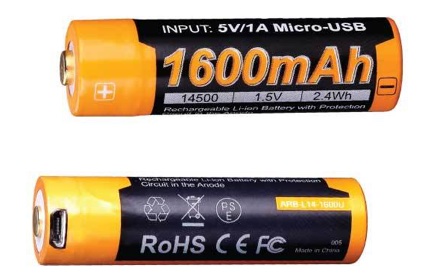
Premium:
Fenix 14500
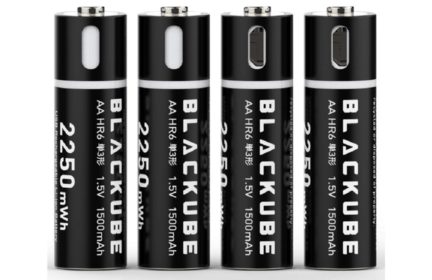
Budget:
Blackube AA
If you’re nervous about your NiMH battery supply’s need for an external charger as a single point of failure, it’s possible to get AA-sized rechargeable batteries in a Li-Ion format with a built-in USB charger, thereby eliminating the dependency on an external charger. Li-Ion rechargeables have far shorter lifespans and shelf lives than NiMH LSD AAs, and much smaller capacities. But if you take care to properly store and maintain them, they can work in the right role as a rechargeable backup battery.
The best USB-rechargeable AA Li-Ion batteries for preppers are the $10 Fenix 14500s because, other than being from a quality brand, their 1600mAh capacity is ~100mAh larger than competitors.
Also great (and about a dollar cheaper per battery) is the $25 four-pack of Blackube AA USB-rechargeable batteries. These well-reviewed batteries have 1500mAh of capacity and will recharge in just 1.5 hours via the built-in USB port.
Warning: When using Li-Ion rechargeable batteries in place of lithium primary batteries, be sure to head all warnings about differences in voltage, charge/discharge patterns, and safe storage.
How to avoid fake batteries
There’s a lot of junk in this market. The best way to ensure you get the best batteries is to exclusively buy Japanese.
Through quirks of history and corporate consolidation, all of the high-quality NiMH LSD batteries in the world come out of a single factory in Japan — regardless of the brand they’re sold under.
Eneloops and Fujitsus, as top-tier brands in the same factory, are basically identical because they both set high standards and receive the cream of the production crop. Plus they’re big clients the factory doesn’t want to upset.
But, as is true for bushcraft hatchets, survival axes, and many other types of gear, products that come from the same factory yet are sold under different brands are not necessarily equivalent in quality. That one factory will try to make more money by selling the leftovers to and/or doing production runs with lower quality standards for other brands willing to sell an inferior product at a lower price point.
That leads some battery reviewers and forum enthusiasts to always be on the lookout for ways to score the most expensive Japanese batteries for less money under an alternate label.
Scammers know this, too. They try to exploit that bargain hunting and consumer confusion with inferior but attractively-priced alternatives.
This is definitely true of Japanese-made NiMH LSD batteries, so to be safe you should exclusively stick with Eneloop and Fujitsu brands. Leave the IKEA and Amazon Basics batteries to the forum geeks.
Tips:
- Buy Japanese-made batteries only from major, trusted retailers like Amazon, Target, Best Buy, Battery Junction, or smaller authorized Panasonic dealers (e.g. Mouser and Digikey).
- When buying on Amazon, only buy when it’s “shipped from and sold by Amazon”, not a third-party vendor.
- Be particularly careful when buying Eneloops. As the most popular and expensive choice, they’ve attracted the most counterfeits.
- Panasonic has the rights to sell Eneloops in the US market, and they do it well. But when outside the US market, Panasonic will mix in some lower-quality Chinese-made batteries — so you won’t necessarily know what you’re getting if you don’t go to extra lengths to explicitly source Japanese batteries.
- Only buy Chinese batteries if you have good reason to trust the source.
How we picked the best rechargeable batteries for preppers
Because batteries are one of those communities that have a core group of super-knowledgeable enthusiasts, there are a number of extremely high-quality, well-researched battery guides out there on the web. We relied heavily on their expertise and detailed testing.
But these guides are all aimed at regular consumer electronics and daily-life scenarios. They assume you’ll always have access to new batteries and a functioning electric grid, for example.
Emergency preparedness has special needs. So we picked the winners based on:
- Number of charge/discharge cycles, that way a single battery can be used repeatedly for the longest possible time in a long-term crisis.
- How well they retain a charge when sitting in storage, so they’re good to go whenever you rarely and suddenly need them.
- No special maintenance needs for long-term storage, like keeping the batteries cold or topping them off.
- Available in common sizes and able to be fit into less common sizes using adapters.
NiMH LSD AA/AAA batteries were the clear winner here, nailing all of the above prepper-specific criteria. There isn’t even a close second.
The first criterion above is the big one that distinguishes our approach from the other consumer-grade battery guides. For normal consumers, it often makes sense to take a major hit on the number of times you can recharge them in order to get more capacity. But for preppers who are investing in an emergency battery supply to last for years, lifespan is key, and the normal NiMH LSD capacity/lifespan tradeoff isn’t even close to worth it.
The only minor downside to the NiMH LSD AA/AAA is that the voltage output is 1.2V, whereas standard alkaline AAs have a 1.5V output. But alkaline AAs only give a full 1.5V when they’re fresh, and they quickly drop down to a lower voltage after, so this isn’t an issue for most AA-powered devices because they’re engineer to handle under 1.5V anyway.
